Are the Significant Ionospheric Anomalies Associated with the 2007 Great Deep-Focus Undersea Jakarta–Java Earthquake?
Abstract
:1. Introduction
2. The 2007 Mw7.5 Jakarta–Java Earthquake
3. Methodology and Observations
3.1. GIM TEC Temporal Anomalies
3.2. TEC Spatial Anomalies
3.3. Ionospheric Plasma Anomalies
4. Possible Natural and Artificial Electromagnetic Background
4.1. Natural Non-Seismic Sources
4.2. The Powerful Ground-Based VLF Transmitters
5. Discussion and Conclusions
Supplementary Materials
Author Contributions
Funding
Data Availability Statement
Acknowledgments
Conflicts of Interest
References
- Jones, L.; Molnar, P. Frequency of foreshocks. Nature 1976, 262, 677–679. [Google Scholar] [CrossRef]
- Sornette, A.; Sornette, D. Self-organized criticality and earthquakes. Europhys. Lett. 1989, 9, 197–202. [Google Scholar] [CrossRef]
- De Santis, A. Geosystemics, Entropy and Criticality of Earthquakes: A Vision of Our Planet and a Key of Access. In Nonlinear Phenomena in Complex Systems: From Nano to Macro Scale; Springer: Berlin/Heidelberg, Germany, 2013; pp. 3–20. [Google Scholar]
- De Santis, A.; De Franceschi, G.; Spogli, L.; Perrone, L.; Alfonsi, L.; Qamili, E.; Cianchini, G.; Di Giovambattista, R.; Salvi, S.; Filippi, E.; et al. Geospace perturbations induced by the Earth: The state of the art and future trends. Phys. Chem. Earth 2015, 85, 17–33. [Google Scholar] [CrossRef]
- Picozza, P.; Conti, L.; Sotgiu, A. Looking for Earthquake Precursors from Space: A Critical Review. Front. Earth Sci. 2021, 9, 578. [Google Scholar] [CrossRef]
- Conti, L.; Picozza, P.; Sotgiu, A. A Critical Review of Ground Based Observations of Earthquake Precursors. Front. Earth Sci. 2021, 9, 676766. [Google Scholar] [CrossRef]
- Liu, J.Y.; Chuo, Y.J.; Shan, S.J.; Tsai, Y.B.; Chen, Y.I.; Pulinets, S.A.; Yu, S.B. Pre-earthquake ionospheric anomalies registered by continuous GPS TEC measurements. Ann. Geophys. Ger. 2004, 22, 1585–1593. [Google Scholar] [CrossRef]
- Liu, J.Y.; Chen, C.H.; Chen, V.I.; Yang, W.H.; Oyama, K.I.; Kuo, K.W. A statistical study of ionospheric earthquake precursors monitored by using equatorial ionization anomaly of GPS TEC in Taiwan during 2001–2007. J. Asian Earth Sci. 2010, 39, 76–80. [Google Scholar] [CrossRef]
- Akhoondzadeh, M.; Parrot, M.; Saradjian, M.R. Electron and ion density variations before strong earthquakes (M > 6.0) using DEMETER and GPS data. Nat. Hazard Earth Sys. 2010, 10, 7–18. [Google Scholar] [CrossRef]
- Tao, D.; Cao, J.; Battiston, R.; Li, L.; Ma, Y.; Liu, W.; Zhima, Z.; Wang, L.; Dunlop, M.W. Seismo-ionospheric anomalies in ionospheric TEC and plasma density before the 17 July 2006 M7.7 south of Java earthquake. Ann. Geophys. Ger. 2017, 35, 589–598. [Google Scholar] [CrossRef]
- Kuo, C.L.; Huba, J.D.; Joyce, G.; Lee, L.C. Ionosphere plasma bubbles and density variations induced by pre-earthquake rock currents and associated surface charges. J. Geophys. Res. Space 2011, 116, A10317. [Google Scholar] [CrossRef]
- Ma, W.; Zhang, X.; Jun, L.; Qi, Y.; Bo, Z.; Chong, Y.; Kang, C.; Xian, L. Influences of multiple layers of air temperature differences on tidal forces and tectonic stress before, during and after the Jiujiang earthquake. Remote Sens. Environ. 2018, 210, 159–165. [Google Scholar] [CrossRef]
- Zhang, X.; Wang, Y.; Boudjada, M.; Liu, J.; Magnes, W.; Zhou, Y.; Du, X. Multi-Experiment Observations of Ionospheric Disturbances as Precursory Effects of the Indonesian Ms6.9 Earthquake on August 05, 2018. Remote Sens. 2020, 12, 4050. [Google Scholar] [CrossRef]
- Parrot, M. Statistical study of ELF/VLF emissions recorded by a low-altitude satellite during seismic events. J. Geophys. Res. Space Phys. 1994, 99, 23339–23347. [Google Scholar] [CrossRef]
- Nemec, F.; Santolik, O.; Parrot, M.; Berthelier, J.J. Spacecraft observations of electromagnetic perturbations connected with seismic activity. Geophys. Res. Lett. 2008, 35, L05109. [Google Scholar] [CrossRef]
- Nemec, F.; Santolik, O.; Parrot, M. Decrease of intensity of ELF/VLF waves observed in the upper ionosphere close to earthquakes: A statistical study. J. Geophys. Res. Space 2009, 114, A04303. [Google Scholar] [CrossRef]
- Pisa, D.; Nemec, F.; Santolik, O.; Parrot, M.; Rycroft, M. Additional attenuation of natural VLF electromagnetic waves observed by the DEMETER spacecraft resulting from preseismic activity. J. Geophys. Res. Space 2013, 118, 5286–5295. [Google Scholar] [CrossRef]
- Ouzounov, D.; Freund, F. Mid-infrared emission prior to strong earthquakes analyzed by remote sensing data. Adv. Space Res. 2004, 33, 268–273. [Google Scholar] [CrossRef]
- Tramutoli, V.; Cuomo, V.; Filizzola, C.; Pergola, N.; Pietrapertosa, C. Assessing the potential of thermal infrared satellite surveys for monitoring seismically active areas: The case of Kocaell (Izmit) earthquake, August 17, 1999. Remote Sens. Environ. 2005, 96, 409–426. [Google Scholar] [CrossRef]
- Ouzounov, D.; Liu, D.; Kang, C.; Cervone, G.; Kafatos, M.; Taylor, P. Outgoing long wave radiation variability from IR satellite data prior to major earthquakes. Tectonophysics 2007, 431, 211–220. [Google Scholar] [CrossRef]
- Lu, X.; Meng, Q.Y.; Gu, X.F.; Zhang, X.D.; Xie, T.; Geng, F. Thermal infrared anomalies associated with multi-year earthquakes in the Tibet region based on China’s FY-2E satellite data. Adv. Space Res. 2016, 58, 989–1001. [Google Scholar] [CrossRef]
- Aleksandrin, S.Y.; Galper, A.M.; Grishantzeva, L.A.; Koldashov, S.V.; Maslennikov, L.V.; Murashov, A.M.; Picozza, P.; Sgrigna, V.; Voronov, S.A. High-energy charged particle bursts in the near-Earth space as earthquake precursors. Ann. Geophys. Ger. 2003, 21, 597–602. [Google Scholar] [CrossRef]
- Sgrigna, V.; Carota, L.; Conti, L.; Corsi, M.; Galper, A.M.; Koldashov, S.V.; Murashov, A.M.; Picozza, P.; Scrimaglio, R.; Stagni, L. Correlations between earthquakes and anomalous particle bursts from SAMPEX/PET satellite observations. J. Atmos. Sol. Terr. Phys. 2005, 67, 1448–1462. [Google Scholar] [CrossRef]
- Battiston, R.; Vitale, V. First evidence for correlations between electron fluxes measured by NOAA-POES satellites and large seismic events. Nucl. Phys. B Proc. Suppl. 2013, 243, 249–257. [Google Scholar] [CrossRef]
- Kuo, C.L.; Lee, L.C.; Huba, J.D. An improved coupling model for the lithosphere-atmosphere-ionosphere system. J. Geophys. Res. Space 2014, 119, 3189–3205. [Google Scholar] [CrossRef]
- Inchin, P.A.; Snively, J.B.; Zettergren, M.D.; Komjathy, A.; Verkhoglyadova, O.P.; Ram, S.T. Modeling of Ionospheric Responses to Atmospheric Acoustic and Gravity Waves Driven by the 2015 Nepal M(w)7.8 Gorkha Earthquake. J. Geophys. Res. Space 2020, 125, e2019JA027200. [Google Scholar] [CrossRef]
- Inchin, P.A.; Snively, J.B.; Kaneko, Y.; Zettergren, M.D.; Komjathy, A. Inferring the Evolution of a Large Earthquake from Its Acoustic Impacts on the Ionosphere. Agu Adv. 2021, 2, e2020AV000260. [Google Scholar] [CrossRef]
- Xiong, P.; Long, C.; Zhou, H.; Battiston, R.; Zhang, X.; Shen, X. Identification of Electromagnetic Pre-Earthquake Perturbations from the DEMETER Data by Machine Learning. Remote Sens. 2020, 12, 3643. [Google Scholar] [CrossRef]
- Xiong, P.; Tong, L.; Zhang, K.; Shen, X.; Battiston, R.; Ouzounov, D.; Iuppa, R.; Crookes, D.; Long, C.; Zhou, H. Towards advancing the earthquake forecasting by machine learning of satellite data. Sci. Total Environ. 2021, 771, 145256. [Google Scholar] [CrossRef]
- Heki, K.; Otsuka, Y.; Choosakul, N.; Hemmakorn, N.; Komolmis, T.; Maruyama, T. Detection of ruptures of Andaman fault segments in the 2004 great Sumatra earthquake with coseismic ionospheric disturbances. J. Geophys. Res. Solid Earth 2006, 111, B09313. [Google Scholar] [CrossRef]
- Liu, J.Y.; Tsai, H.F.; Lin, C.H.; Kamogawa, M.; Chen, Y.I.; Lin, C.H.; Huang, B.S.; Yu, S.B.; Yeh, Y.H. Coseismic ionospheric disturbances triggered by the Chi-Chi earthquake. J. Geophys. Res. Space 2010, 115, A08303. [Google Scholar] [CrossRef]
- Song, Q.; Ding, F.; Yu, T.; Wan, W.; Ning, B.; Liu, L.; Zhao, B. GPS detection of the coseismic ionospheric disturbances following the 12 May 2008 M7.9 Wenchuan earthquake in China. Sci. China Earth Sci. 2015, 58, 151–158. [Google Scholar] [CrossRef]
- Gao, Y.; Harris, J.M.; Wen, J.; Huang, Y.; Twardzik, C.; Chen, X.; Hu, H. Modeling of the coseismic electromagnetic fields observed during the 2004 M-w 6.0 Parkfield earthquake. Geophys. Res. Lett. 2016, 43, 620–627. [Google Scholar] [CrossRef]
- Ram, S.T.; Sunil, P.S.; Kumar, M.R.; Su, S.Y.; Tsai, L.C.; Liu, C.H. Coseismic Traveling Ionospheric Disturbances during the M-w 7.8 Gorkha, Nepal, Earthquake on 25 April 2015 from Ground and Spaceborne Observations. J. Geophys. Res. Space 2017, 122, 10669–10685. [Google Scholar] [CrossRef]
- Liu, H.; Zhang, K.; Imtiaz, N.; Song, Q.; Zhang, Y. Relating Far-Field Coseismic Ionospheric Disturbances to Geological Structures. J. Geophys. Res. Space 2021, 126, e2021JA029209. [Google Scholar] [CrossRef]
- Pustovetov, V.P.; Malyshev, A.B. Space–time correlation of earthquakes and high-energy particle flux variations in the inner radiation belt. Cosm. Res. 1993, 31, 84–90. [Google Scholar]
- Le, H.; Liu, J.Y.; Liu, L. A statistical analysis of ionospheric anomalies before 736 M6.0+earthquakes during 2002–2010. J. Geophys. Res. Space 2011, 116, A02303. [Google Scholar] [CrossRef]
- Xia, C.; Yang, S.; Xu, G.; Zhao, B.; Yu, T. Ionospheric Anomalies Observed by GPS TEC Prior to the Qinghai-Tibet Region Earthquakes. Terr. Atmos. Ocean Sci. 2011, 22, 177–185. [Google Scholar] [CrossRef]
- Harper, W.R. The generation of static charge. Adv. Phys. 1957, 6, 365–417. [Google Scholar] [CrossRef]
- Blanchard, D.C. The electrification of the atmosphere by particles from bubbles in the sea. Prog. Oceanogr. 1963, 1, 73–202. [Google Scholar] [CrossRef]
- King, C.Y. Gas geochemistry applied to earthquake prediction: An overview. J. Geophys. Res. Solid Earth 1986, 91, 12269–12281. [Google Scholar] [CrossRef]
- Zavarsky, A.; Booge, D.; Fiehn, A.; Kruger, K.; Atlas, E.; Marandino, C. The Influence of Air-Sea Fluxes on Atmospheric Aerosols During the Summer Monsoon Over the Tropical Indian Ocean. Geophys. Res. Lett. 2018, 45, 418–426. [Google Scholar] [CrossRef]
- Revell, L.E.; Kremser, S.; Hartery, S.; Harvey, M.; Mulcahy, J.P.; Williams, J.; Morgenstern, O.; McDonald, A.J.; Varma, V.; Bird, L.; et al. The sensitivity of Southern Ocean aerosols and cloud microphysics to sea spray and sulfate aerosol production in the HadGEM3-GA7.1 chemistry-climate model. Atmos. Chem. Phys. 2019, 19, 15447–15466. [Google Scholar] [CrossRef]
- Sorokin, V.M.; Chmyrev, V.M.; Hayakawa, M. A Review on Electrodynamic Influence of Atmospheric Processes to the Ionosphere. Open J. Earthq. Res. 2020, 9, 113–141. [Google Scholar] [CrossRef]
- Blanc, E. Observations in the upper atmosphere of infrasonic waves from natural or artificial sources-A summary. Ann. Geophys. Ger. 1985, 3, 673–687. [Google Scholar]
- Kaladze, T.D.; Pokhotelov, O.A.; Shah, H.A.; Khan, M.I.; Stenflo, L. Acoustic-gravity waves in the Earth’s ionosphere. J. Atmos. Sol. Terr. Phys. 2008, 70, 1607–1616. [Google Scholar] [CrossRef]
- Godin, O.A. Acoustic-gravity waves in atmospheric and oceanic waveguides. J. Acoust. Soc. Am. 2012, 132, 657–669. [Google Scholar] [CrossRef]
- Zettergren, M.D.; Snively, J.B. Ionospheric response to infrasonic-acoustic waves generated by natural hazard events. J. Geophys. Res. Space 2015, 120, 8002–8024. [Google Scholar] [CrossRef]
- Kadri, U. Tsunami mitigation by resonant triad interaction with acoustic-gravity waves. Heliyon 2017, 3, e00234. [Google Scholar] [CrossRef]
- Yang, S.-S.; Asano, T.; Hayakawa, M. Abnormal Gravity Wave Activity in the Stratosphere Prior to the 2016 Kumamoto Earthquakes. J. Geophys. Res. Space 2019, 124, 1410–1425. [Google Scholar] [CrossRef]
- Kakinami, Y.; Kamogawa, M.; Tanioka, Y.; Watanabe, S.; Gusman, A.R.; Liu, J.-Y.; Watanabe, Y.; Mogi, T. Tsunamigenic ionospheric hole. Geophys. Res. Lett. 2012, 39, L00G27. [Google Scholar] [CrossRef]
- Song, R.; Hattori, K.; Zhang, X.; Sanaka, S. Seismic-ionospheric effects prior to four earthquakes in Indonesia detected by the China seismo-electromagnetic satellite. J. Atmos. Sol. Terr. Phys. 2020, 205, 105291. [Google Scholar] [CrossRef]
- Roma-Dollase, D.; Hernandez-Pajares, M.; Krankowski, A.; Kotulak, K.; Ghoddousi-Fard, R.; Yuan, Y.; Li, Z.; Zhang, H.; Shi, C.; Wang, C.; et al. Consistency of seven different GNSS global ionospheric mapping techniques during one solar cycle. J. Geod. 2018, 92, 691–706. [Google Scholar] [CrossRef]
- Parrot, M.; Benoist, D.; Berthelier, J.J.; Blecki, J.; Chapuis, Y.; Colin, F.; Elie, F.; Fergeau, P.; Lagoutte, D.; Lefeuvre, F.; et al. The magnetic field experiment IMSC and its data processing onboard DEMETER: Scientific objectives, description and first results. Planet Space Sci. 2006, 54, 441–455. [Google Scholar] [CrossRef]
- Dobrovolsky, I.P.; Zubkov, S.I.; Miachkin, V.I. Estimation of the size of earthquake preparation zones. Pure Appl. Geophys. 1979, 117, 1025–1044. [Google Scholar] [CrossRef]
- Pulinets, S.A.; Legen’ka, A.D.; Gaivoronskaya, T.V.; Depuev, V.K. Main phenomenological features of ionospheric precursors of strong earthquakes. J. Atmos. Sol. Terr. Phys. 2003, 65, 1337–1347. [Google Scholar] [CrossRef]
- Pulinets, S.; Davidenko, D. Ionospheric precursors of earthquakes and Global Electric Circuit. Adv. Space Res. 2014, 53, 709–723. [Google Scholar] [CrossRef]
- Pulinets, S.A.; Ouzounov, D.P.; Karelin, A.V.; Davidenko, D.V. Physical bases of the generation of short-term earthquake precursors: A complex model of ionization-induced geophysical processes in the lithosphere-atmosphere-ionosphere-magnetosphere system. Geomagn. Aeron. 2015, 55, 521–538. [Google Scholar] [CrossRef]
- Liu, J.Y.; Chen, Y.I.; Chen, C.H.; Hattori, K. Temporal and spatial precursors in the ionospheric global positioning system (GPS) total electron content observed before the 26 December 2004 M9.3 Sumatra-Andaman Earthquake. J. Geophys. Res. Space 2010, 115, A09312. [Google Scholar] [CrossRef]
- Liu, J.; Zhang, X.; Novikov, V.; Shen, X. Variations of ionospheric plasma at different altitudes before the 2005 Sumatra Indonesia M-s 7.2 earthquake. J. Geophys. Res. Space 2016, 121, 9179–9187. [Google Scholar] [CrossRef]
- Zhima, Z.; Cao, J.; Liu, W.; Fu, H.; Wang, T.; Zhang, X.; Shen, X. Storm time evolution of ELF/VLF waves observed by DEMETER satellite. J. Geophys. Res. Space 2014, 119, 2612–2622. [Google Scholar] [CrossRef]
- Voss, H.D.; Imhof, W.L.; Walt, M.; Mobilia, J.; Gaines, E.E.; Reagan, J.B.; Inan, U.S.; Helliwell, R.A.; Carpenter, D.L.; Katsufrakis, J.P.; et al. Lightning-induced electron precipitation. Nature 1984, 312, 740–742. [Google Scholar] [CrossRef]
- Rodger, C.J.; Cho, M.G.; Clilverd, M.A.; Rycroft, M.J. Lower ionospheric modification by lightning-EMP: Simulation of the night ionosphere over the United States. Geophys. Res. Lett. 2001, 28, 199–202. [Google Scholar] [CrossRef]
- Parrot, M.; Berthelier, J.J.; Lebreton, J.P.; Treumann, R.; Rauch, J.L. DEMETER observations of EM emissions related to thunderstorms. Space Sci. Rev. 2008, 137, 511–519. [Google Scholar] [CrossRef]
- Parrot, M.; Sauvaud, J.A.; Soula, S.; Pincon, J.L.; van der Velde, O. Ionospheric density perturbations recorded by DEMETER above intense thunderstorms. J. Geophys. Res. Space 2013, 118, 5169–5176. [Google Scholar] [CrossRef]
- Cao, J.; Yang, J.; Yuan, S.; Shen, X.; Liu, Y.; Yan, C.; Li, W.; Chen, T. In-flight observations of electromagnetic interferences emitted by satellite. Sci. China Ser. E Technol. Sci. 2009, 52, 2112–2118. [Google Scholar] [CrossRef]
- Zhima, Z.; Shen, X.; Zhang, X.; Cao, J.; Huang, J.; Ouyang, X.; Jing, L.; Lu, B. Possible Ionospheric Electromagnetic Perturbations Induced by the Ms7.1 Yushu Earthquake. Earth Moon Planets 2012, 108, 231–241. [Google Scholar] [CrossRef]
- Chen, L.; Santolik, O.; Hajos, M.; Zheng, L.; Zhima, Z.; Heelis, R.; Hanzelka, M.; Horne, R.B.; Parrot, M. Source of the low-altitude hiss in the ionosphere. Geophys. Res. Lett. 2017, 44, 2060–2069. [Google Scholar] [CrossRef]
- Chen, L.; Pfaff, R.; Heelis, R.; Boardsen, S.; Xia, Z. Ion Cyclotron Resonant Absorption Lines in ELF Hiss Power Spectral Density in the Low-Latitude Ionosphere. Geophys. Res. Lett. 2020, 47, e2019GL086315. [Google Scholar] [CrossRef]
- Sauvaud, J.A.; Maggiolo, R.; Jacquey, C.; Parrot, M.; Berthelier, J.J.; Gamble, R.J.; Rodger, C.J. Radiation belt electron precipitation due to VLF transmitters: Satellite observations. Geophys. Res. Lett. 2008, 35, L09101. [Google Scholar] [CrossRef]
- Gamble, R.J.; Rodger, C.J.; Clilverd, M.A.; Sauvaud, J.-A.; Thomson, N.R.; Stewart, S.L.; McCormick, R.J.; Parrot, M.; Berthelier, J.-J. Radiation belt electron precipitation by man-made VLF transmissions. J. Geophys. Res. Space 2008, 113, A10211. [Google Scholar] [CrossRef]
- Li, X.; Ma, Y.; Wang, P.; Wang, H.; Lu, H.; Zhang, X.; Huang, J.; Shi, F.; Yu, X.; Xu, Y.; et al. Study of the North West Cape electron belts observed by DEMETER satellite. J. Geophys. Res. Space Phys. 2012, 117, A04201. [Google Scholar] [CrossRef]
- Selesnick, R.S.; Albert, J.M.; Starks, M.J. Influence of a ground-based VLF radio transmitter on the inner electron radiation belt. J. Geophys. Res. Space Phys. 2013, 118, 628–635. [Google Scholar] [CrossRef]
- Sauvaud, J.A.; Walt, M.; Delcourt, D.; Benoist, C.; Penou, E.; Chen, Y.; Russell, C.T. Inner radiation belt particle acceleration and energy structuring by drift resonance with ULF waves during geomagnetic storms. J. Geophys. Res. Space 2013, 118, 1723–1736. [Google Scholar] [CrossRef]
- Liu, J.Y.; Chen, Y.I.; Chen, C.H.; Liu, C.Y.; Chen, C.Y.; Nishihashi, M.; Li, J.Z.; Xia, Y.Q.; Oyama, K.I.; Hattori, K.; et al. Seismoionospheric GPS total electron content anomalies observed before the 12 May 2008 M(w)7.9 Wenchuan earthquake. J. Geophys. Res. Space 2009, 114, A04320. [Google Scholar] [CrossRef]
- Pulinets, S. Ionospheric precursors of earthquakes; Recent advances in theory and practical applications. Terr. Atmos. Ocean Sci. 2004, 15, 413–435. [Google Scholar] [CrossRef]
- Sidiropoulos, N.F.; Anagnostopoulos, G.; Rigas, V. Comparative study on earthquake and ground based transmitter induced radiation belt electron precipitation at middle latitudes. Nat. Hazard Earth Syst. 2011, 11, 1901–1913. [Google Scholar] [CrossRef]
- Dudkin, F.; Korepanov, V.; Dudkin, D.; Pilipenko, V.; Pronenko, V.; Klimov, S. Electric field of the power terrestrial sources observed by microsatellite Chibis-M in the Earth’s ionosphere in frequency range 1-60 Hz. Geophys. Res. Lett. 2015, 42, 5686–5693. [Google Scholar] [CrossRef]
- Pulinets, S.A.; Boyarchuk, K.A.; Hegai, V.V.; Kim, V.P.; Lomonosov, A.M. Quasielectrostatic model of atmosphere-thermosphere-ionosphere coupling. Adv. Space Res. 2000, 26, 1209–1218. [Google Scholar] [CrossRef]
- Pulinets, S.A.; Boyarchuk, K.A.; Lomonosov, A.M.; Khegai, V.V.; Lyu, I.Y. Ionospheric precursors to earthquakes: A preliminary analysis of the foF2 critical frequencies at Chung-Li ground-based station for vertical sounding of the ionosphere (Taiwan Island). Geomagn. Aeron. 2002, 42, 508–513. [Google Scholar]
- Korepanov, V.; Hayakawa, M.; Yampolski, Y.; Lizunov, G. AGW as a seismo-ionospheric coupling responsible agent. Phys. Chem. Earth 2009, 34, 485–495. [Google Scholar] [CrossRef]
- Hayakawa, M.; Asano, T.; Rozhnoi, A.; Solovieva, M. Very-Low and Low-Frequency Sounding of Ionospheric Perturbations and Possible Association with Earthquakes. In Pre-Earthquake Process: A Multidisciplinary Approach to Earthquake Prediction Studies; Ouzounov, D., Pulinets, S., Hattori, K., Taylor, P., Eds.; AGU: Washington, DC, USA, 2018; pp. 277–304. [Google Scholar]
- Garavaglia, M.; Dal Moro, G.; Zadro, M. Radon and tilt measurements in a seismic area: Temperature effects. Phys. Chem. Earth Part A-Solid Earth Geod. 2000, 25, 233–237. [Google Scholar] [CrossRef]
- Silva, A.A.; Claro, L.H. Surface air radon progeny at Sao Jose dos Campos, Brazil. Atmos. Environ. 2005, 39, 4619–4625. [Google Scholar] [CrossRef]
- Pulinets, S.A.; Ouzounov, D.; Karelin, A.V.; Boyarchuk, K.A.; Pokhmelnykh, L.A. The physical nature of thermal anomalies observed before strong earthquakes. Phys. Chem. Earth 2006, 31, 143–153. [Google Scholar] [CrossRef]
- Molchanov, O.; Rozhnoi, A.; Solovieva, M.; Akentieva, O.; Berthelier, J.J.; Parrot, M.; Lefeuvre, F.; Biagi, P.F.; Castellana, L.; Hayakawa, M. Global diagnostics of the ionospheric perturbations related to the seismic activity using the VLF radio signals collected on the DEMETER satellite. Nat. Hazard Earth Syst. 2006, 6, 745–753. [Google Scholar] [CrossRef]
- Pulinets, S.; Ouzounov, D. Lithosphere-Atmosphere-Ionosphere Coupling (LAIC) model—An unified concept for earthquake precursors validation. J. Asian Earth Sci. 2011, 41, 371–382. [Google Scholar] [CrossRef]
- Chen, C.-H.; Sun, Y.-Y.; Lin, K.; Zhou, C.; Xu, R.; Qing, H.; Gao, Y.; Chen, T.; Wang, F.; Yu, H.; et al. A New Instrumental Array in Sichuan, China, to Monitor Vibrations and Perturbations of the Lithosphere, Atmosphere, and Ionosphere. Surv. Geophys. 2021, 42, 1425–1442. [Google Scholar] [CrossRef]
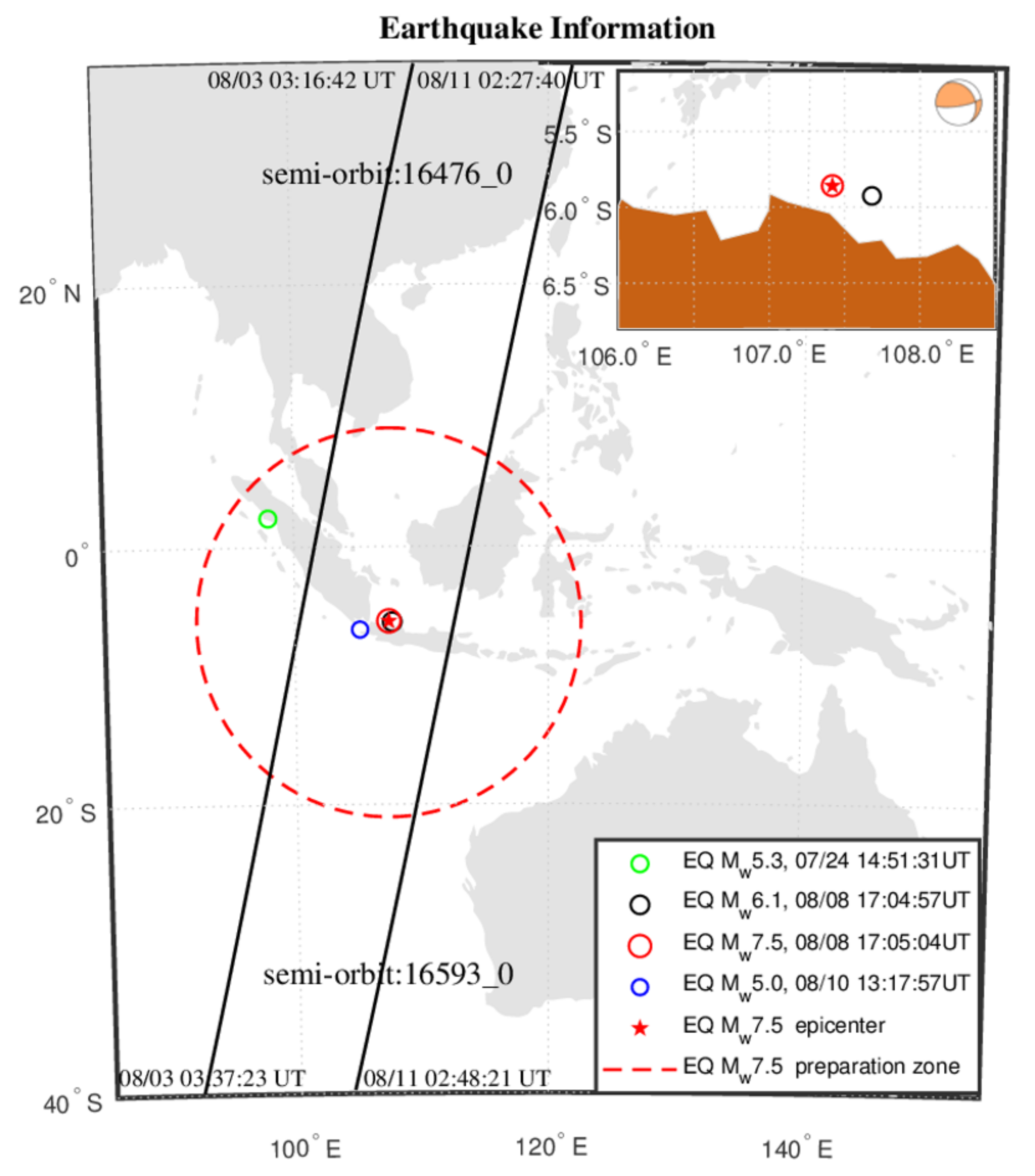
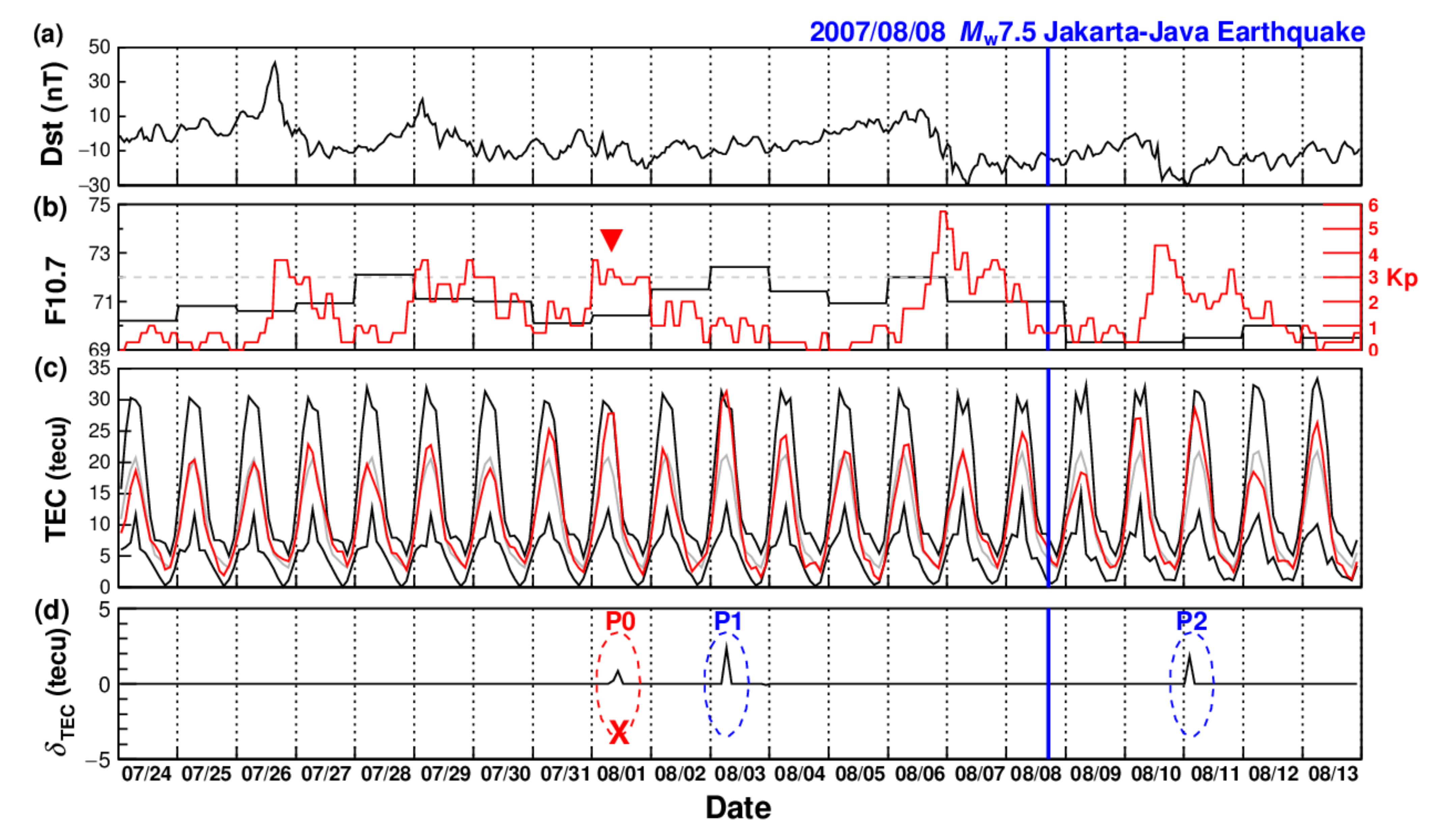
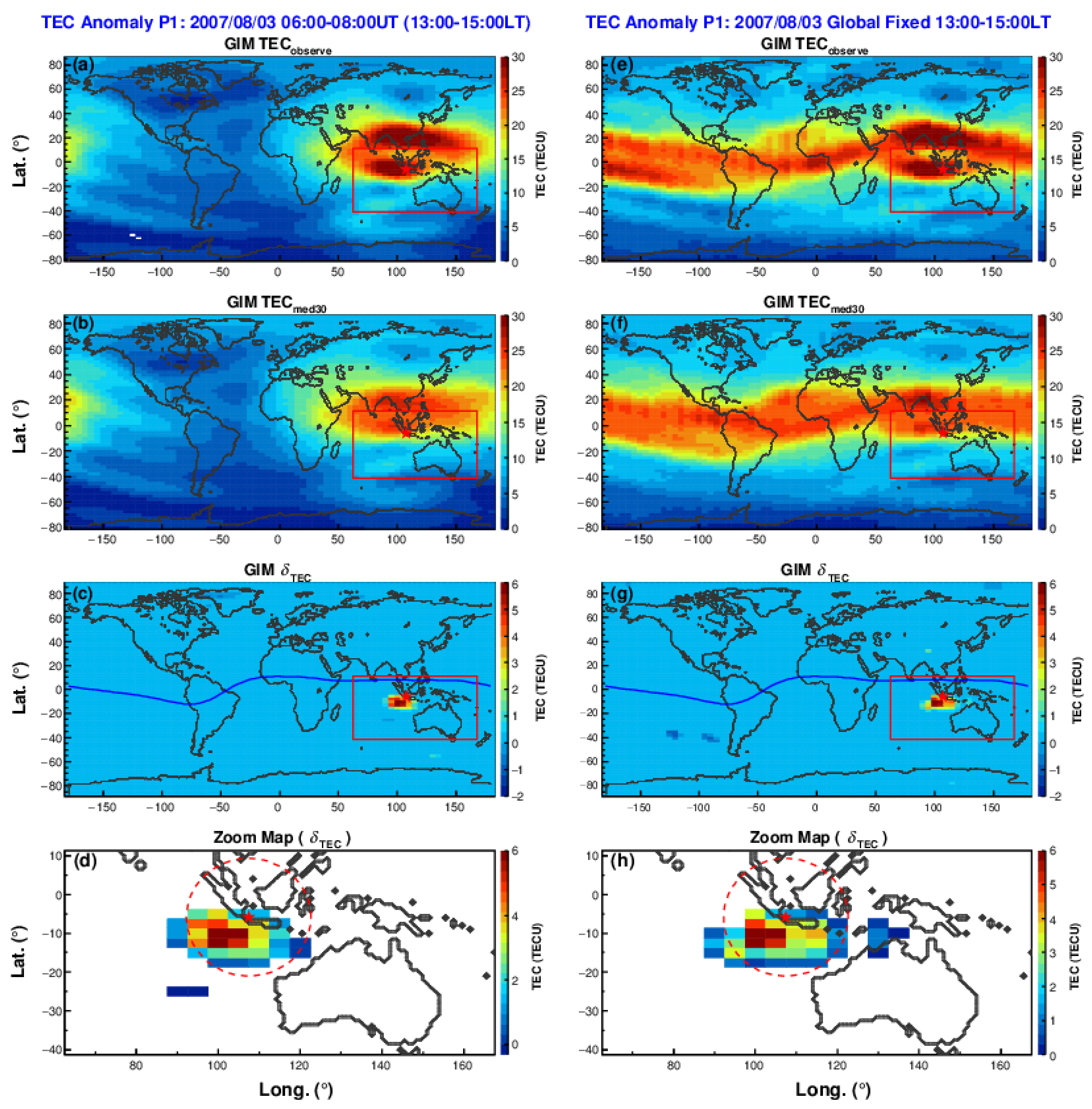

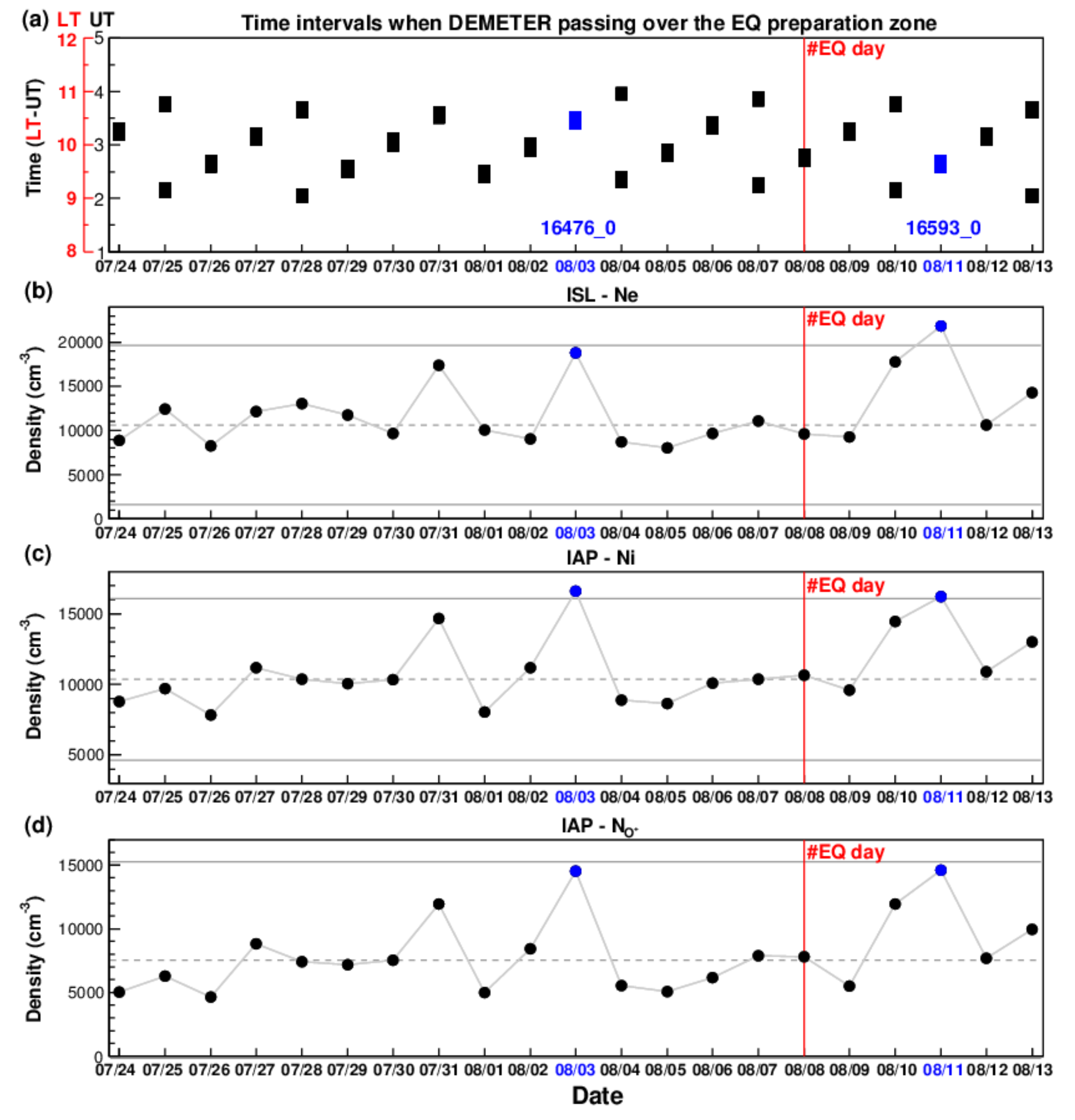
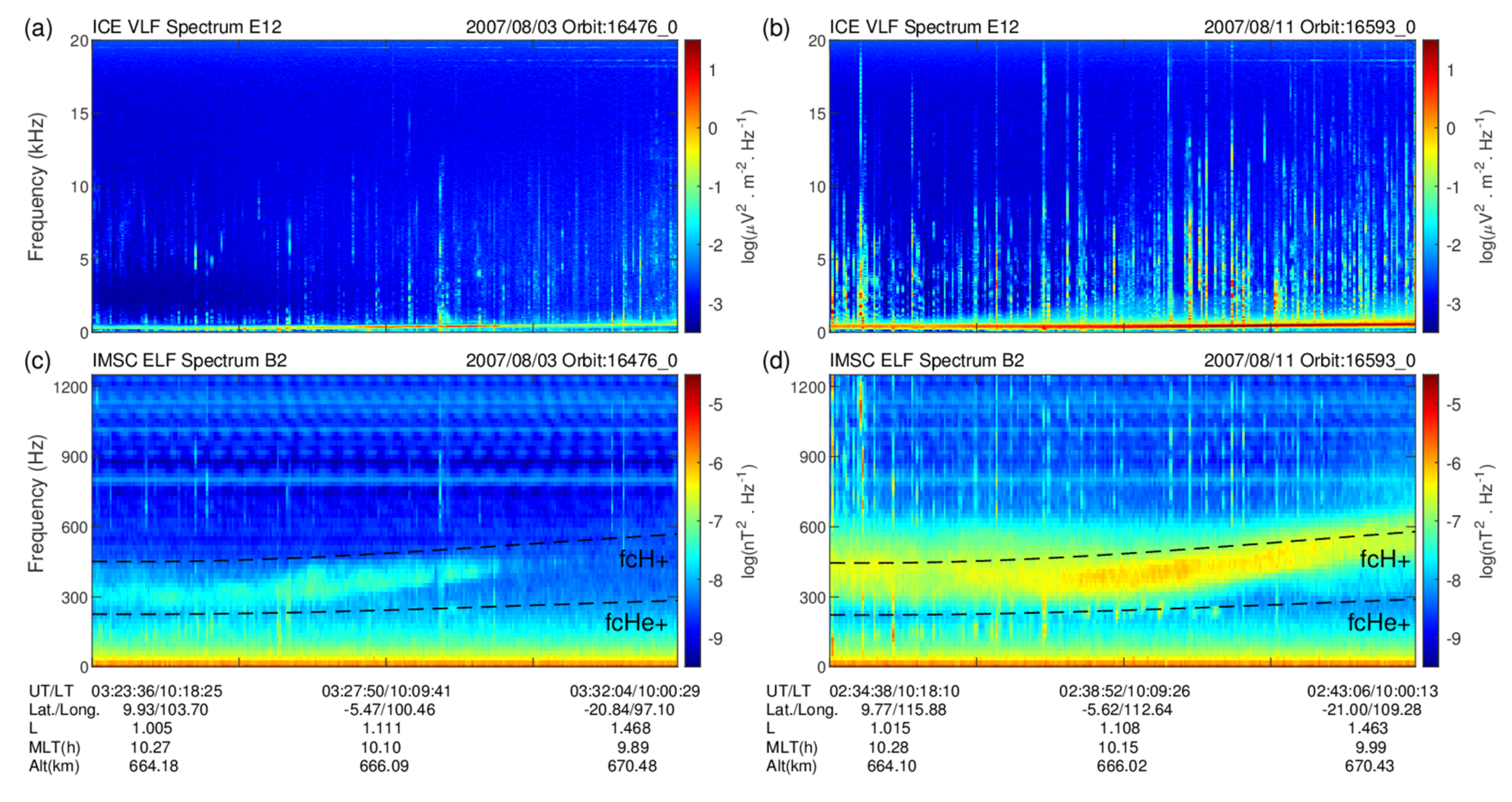
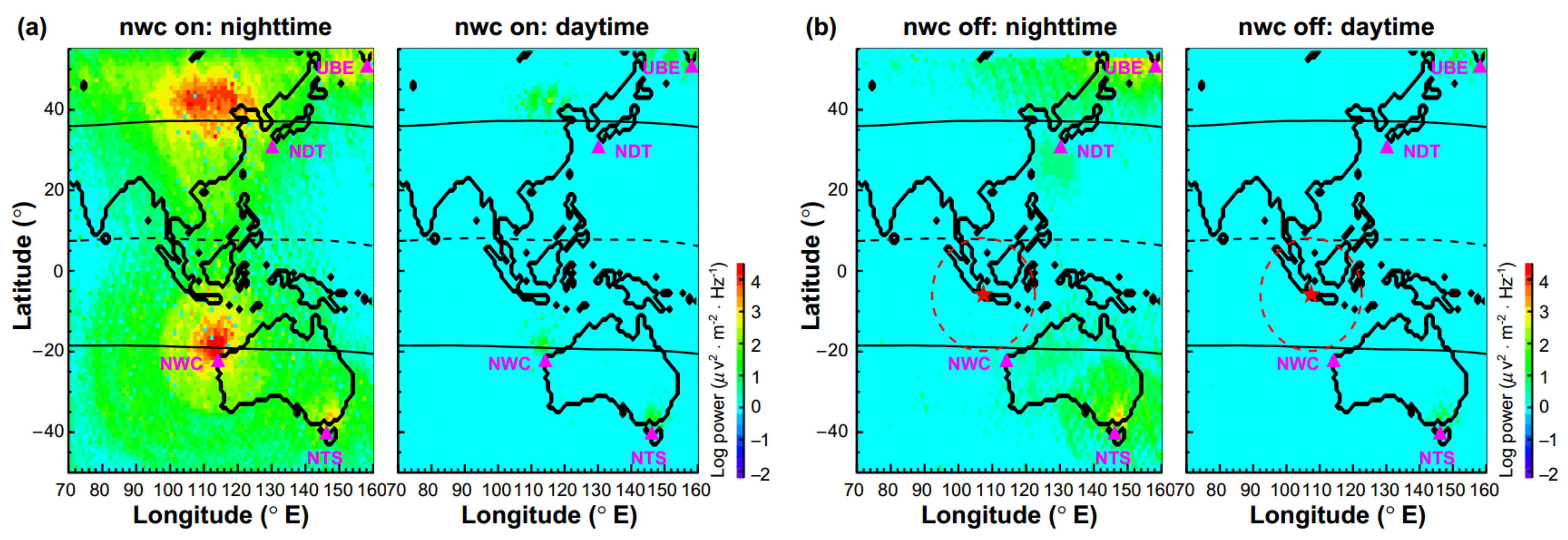
| No. | NAME | LAT. | LONG. | FREQ. (kHz) |
|---|---|---|---|---|
| 1 | UBE | 52.90 | 158.55 | 16.20 |
| 2 | NTS | −38.48 | 146.93 | 18.60 |
| 3 | NWC | −21.82 | 114.17 | 19.80 |
| 4 | NDT | 32.08 | 130.83 | 22.20 |
Publisher’s Note: MDPI stays neutral with regard to jurisdictional claims in published maps and institutional affiliations. |
© 2022 by the authors. Licensee MDPI, Basel, Switzerland. This article is an open access article distributed under the terms and conditions of the Creative Commons Attribution (CC BY) license (https://creativecommons.org/licenses/by/4.0/).
Share and Cite
Tao, D.; Wang, G.; Zong, J.; Wen, Y.; Cao, J.; Battiston, R.; Zeren, Z. Are the Significant Ionospheric Anomalies Associated with the 2007 Great Deep-Focus Undersea Jakarta–Java Earthquake? Remote Sens. 2022, 14, 2211. https://doi.org/10.3390/rs14092211
Tao D, Wang G, Zong J, Wen Y, Cao J, Battiston R, Zeren Z. Are the Significant Ionospheric Anomalies Associated with the 2007 Great Deep-Focus Undersea Jakarta–Java Earthquake? Remote Sensing. 2022; 14(9):2211. https://doi.org/10.3390/rs14092211
Chicago/Turabian StyleTao, Dan, Guangxue Wang, Jiayi Zong, Yuanzheng Wen, Jinbin Cao, Roberto Battiston, and Zhima Zeren. 2022. "Are the Significant Ionospheric Anomalies Associated with the 2007 Great Deep-Focus Undersea Jakarta–Java Earthquake?" Remote Sensing 14, no. 9: 2211. https://doi.org/10.3390/rs14092211
APA StyleTao, D., Wang, G., Zong, J., Wen, Y., Cao, J., Battiston, R., & Zeren, Z. (2022). Are the Significant Ionospheric Anomalies Associated with the 2007 Great Deep-Focus Undersea Jakarta–Java Earthquake? Remote Sensing, 14(9), 2211. https://doi.org/10.3390/rs14092211









